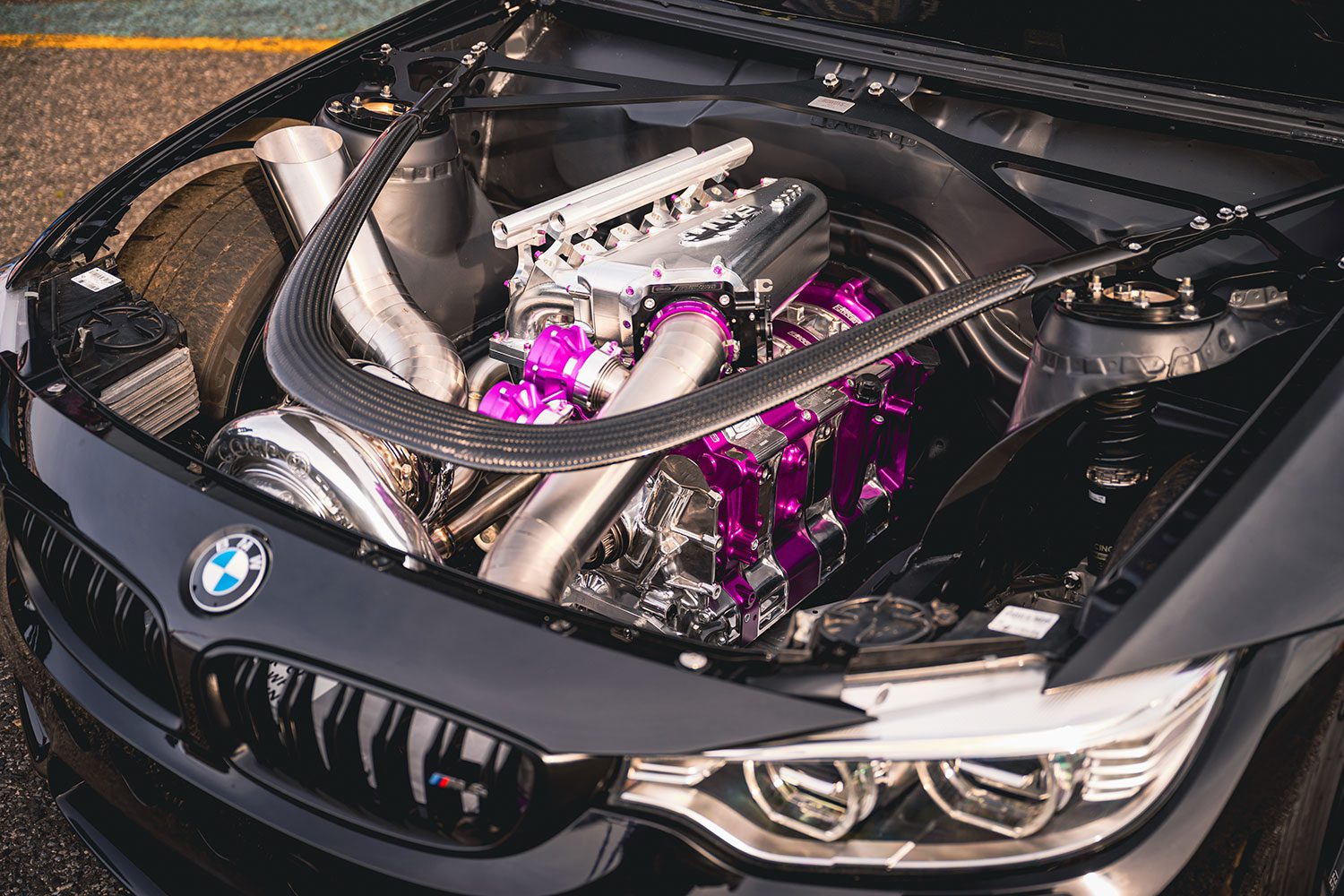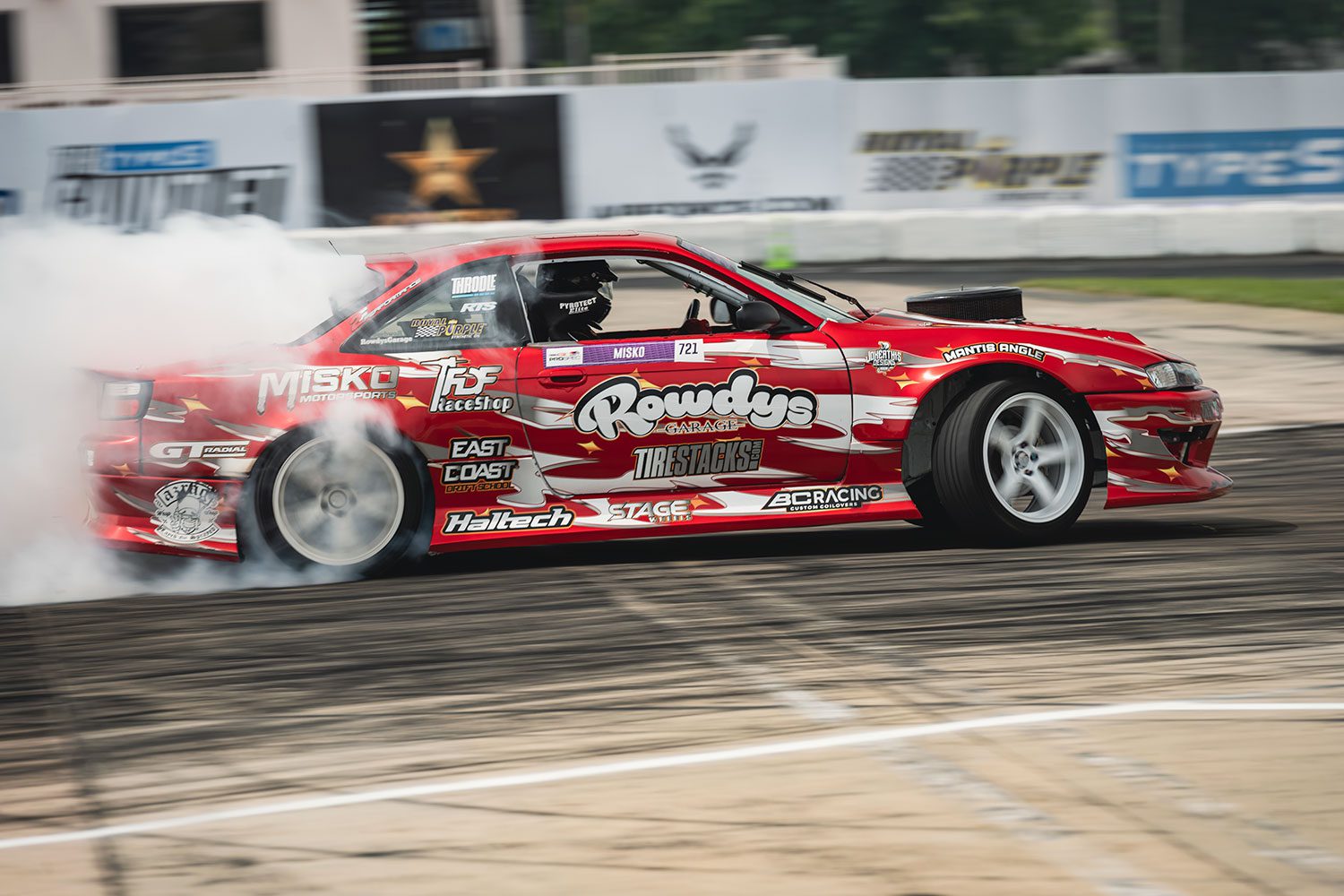

I grew up in New Jersey in the shadows of Englishtown Raceway, better known as Raceway Park. As soon as I was legally allowed, I brought my old 3000GT to the drag strip. But drag racing lost its appeal over the years, and sadly, Raceway Park’s strip closed. That’s not the end though because now, 20 years later, it’s hosting Formula Drift events each year. But what is Formula “D”, and is it even a real sport? I head to the Gauntlet to find out.


What is Formula Drift?
Think of your favorite Fast and Furious movie, and Toyko Drift probably isn’t the one that comes to mind. But it might be the one that’s closest to the culture those movies try to emulate. Formula Drift takes that spirit and turns it into a live action event.
Each season has eight races held across the country. Time isn’t important here. Instead, drivers are judged on their ability to drift around a predefined track, hitting marks on certain clipping points along the way. Points are given for the driving line taken, angle of the drift, and style. Being judged is a key element in Formula Drift vs other motorsports. The clock can’t give style points.




How does Formula Drift work?
Three judges make the calls for each event. Drivers are rated on speed, line, angle and style.
- Speed: The faster (and smoother) you go through the drift course, the better.
- Line: The ideal path a driver should take. It’s marked with clipping points that a driver must bring their car close to, but not touch. The closer you are, the more points you’ll score.
- Angle: These cars have front wheels that can steer almost perpendicular to the car. The more angle you can hold, the better your drift is.
- Style: What makes a pretty drift? You’ll know it when you see it, and so will the judges. But hard, smooth flicks of the wheel, angle, speed, even the driver’s own personal style – it all comes together here.


The drivers look for “clipping points” and “clipping zones”. A clipping point is a specific spot on the track marked by a cone, usually the apex of a curve. Clipping points are always on the inside of a turn. Clipping zones are areas of varying size that have two markers, one at the beginning of the zone and one at the end, and are always on the outside of a turn.
While the lead car might have the ability to control the angle and speed, car two can earn points by sticking close to the lead. Knocking doors is common. But overtaking the lead car is discouraged.




What’s a Formula Drift Competition like?
Currently, there’s a day for qualifying, where cars are allowed two solo drift runs. Results form a bracket for the actual competition itself the next day. Two cars will get two runs on the track. On the first run, car one is the lead car, and they control the time to depart the line. On the second run, car two takes the lead position with the same advantages, giving both drivers equal opportunity.
There are also “Competition time outs” in case something breaks on the car. Things often do.






Do Formula Drift judges make mistakes?
As one of the few motorsport series that relies on something besides the stop watch, human error is part of the game. But there are safeguards. Two judges can override the third. They can use instant replay. One judge handles one portion of the competition (style judge, line judge and angle judge). If it’s too close to call, they will have a “One more time” run to decide the winner.
What’s fun is the pause after the action. As the judges review, everyone waits in anticipation of the winner.




What cars are used in Formula Drift?
There is no defined “car” like in Formula 1, but there are rules. The car must be rear-wheel drive and use the original steel frame. You can use an all-wheel drive car like a Mitsu Evo, but it must be converted to rear-wheel drive.
Each Formula Drift car must be from “production” with a run of at least 600 units. No SUVs are allowed (sorry Jag SVR).


Power units are all over the place. You can put many things inside, from keeping the original engine to fitting in a small-block Chevy V-8. The V-8 is a popular option. Parts are cheap and easy to find, and the power is plentiful. I do find it ironic that in a sport bred from the import tuner scene, a small-block is the power plant of choice. In the import vs domestic debate, there is still no replacement for displacement.
But what do you find? Everything from my love, an E92 M3, to Nissan Z cars (even the new Z!), Toyobaru twins and even a Ferrari. But the dominant platform seems to be the Nissan 240SX, or Silvia in Japan.




Does BMW have a presence in Formula Drift?


No. But they are still represented well, with various E36 and E46 chassis on hand. My personal favorite was Blake Olsen’s 2007 E92. What started out in life as a stock 328i was fully stripped and rebuilt from the ground up into a drifting machine. But you won’t find an S65 under the hood. Blasphemy, you say? Out here, you need power and torque, not exactly an S65 strong suite. Enter the LS7. This car sounded incredible, and for a minute I thought there actually was BMW’s famed V-8 under the hood. No surprise there, as the redline is actually 300 rpm higher in the LS7. Power? 650 horses. Speaking of which…


How much power does a Formula Drift car make?


You need power to get the tail out, but how much you need is up to you and your team. This is the wild west of racing. Bigger engines? Sure. Turbos? Cool. Nitrous injection? Yup. Cars can pump out in excess of 1,200 horses. The only limits seem to be the team’s budget.
Batteries are also a possibility, and a few cars have tried them out. But for now, it’ still the trusty 2JZ, VQ, LS9, and even a Mazda rotary.




How do you become a Formula Drift driver?
Like with any other racing series, it takes time, money, practice and patience. Most of the driver are young, as in 19 and up, and it helps to have a winning personality (no Kimi Räikkönen impersonators here).


Formula Drift has a feeder series, the Pro Am Affiliate, that helps cultivate talent. Each year, the top drivers from Pro Am obtain their professional drifting license, earning the ability to compete at the top level of the sport. There is talk of adding a third series in between to assist drivers, as jumping from amateur to pro can be challenging.
Driving, and by extension drifting, is a physically demanding sport that requires the same endurance as any other professional athlete. I’m not sure I could have done what these drivers are doing at such a young age.


How does a Formula Drift team work?




To really give this a go, you need sponsorships. A team needs mechanics, a car, spare parts, a driver, travel expenses and many tires. Winning drivers don’t make enough to cover the team’s expenses, so sponsorships are key. But if you take a look at the sizeable crowd, you’ll see that it consists mainly of the coveted 18-24 age bracket for marketing.




How do you drift a Formula D car?
There’s a reason these cars all have immense power, and it makes kicking the tail out as easy as it can be. But once it’s out, you have to hold it there – that’s the drift part. A limited slip differential is considered key. You can go without one, but it’s not likely you’ll be successful. Clutches are also strengthened so that “clutch kicks” are consistently possible. You quickly press the clutch down under high power, then pop it up to get the tires to lose grip.
Inside, drivers usually move the hand brake location or add an extra hydraulic hand brake actuator for greater braking force.The front suspension is also adjusted to allow for much greater steering angles, usually upwards of 60 degrees.
All of this means the car is easier to control at the limit. To put it in terms that a normal driver might understand, think of it like writing with a pencil on paper. Press too lightly, and you won’t leave a mark. Press too firmly, and you’ll punch a hole through the paper. Drifting is just like that – finding the right balance of power to hold the line, but not go beyond it. It’s a special skill.
So, is Formula D a real sport?
Of course it is, and it’s growing. I’m glad that Raceway Park is able to hold a round, keeping the spirit of the place intact. I’ll be back next year!


Formula Drift Mega Gallery


















































































Commissions may be received for product links on this site. Help out if you can.
I use Nikon camera bodies and lenses, a Westcott Ice Light 2, Manfrotto tripod, B + W filters and an iMac Pro to make the art you see here.
Email me at mike@machineswithsouls.com with any questions. Follow along on Instagram @machineswithsouls
















